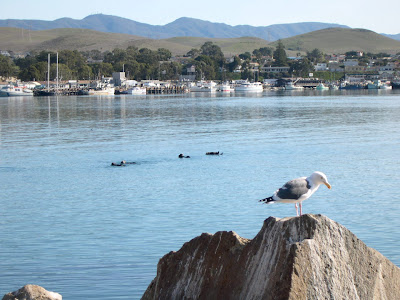We found a reasonably-priced room looking over the water, an expensive but tasty Italian dinner, and the next morning lucked into meeting Bob Eiseberg. Bob apparently works for a living driving heavy equipment, but his love is obviously tracking the rare and wonderful Peregrine falcons that nest and play around Morro Rock.
We found Bob standing by his truck, and telescope, enjoying the morning sun and a cup of coffee. He was a wonderful and willing source of information about the wildlife along this part of the California coast.

Bob apparently spends a lot of his time in the parking lot on the south side of Morro Rock, helping people like us, and sharing his telescope.

Shortly after we left him several school groups came in busloads, and the teachers were "looking for Bob."
He told us about two nesting pairs of falcons that live high up on the rock. Showed us through his telescope the a male on the butcher block (dining table) where it devours its prey. Showed us the female on a nearby rock, and discussed the mating and nesting habits.
Here's a bad picture of the nest area:

And a borrowed picture so you can see this beautiful bird:

Peregrine falcons are the fastest birds in the world, they fly up to 200 miles an hour to capture their flying prey on the wing, and we almost killed them all with DDT and other habitat impacts in the mid-1900's. But thanks to the Endangered Species Act, and the resilience of the birds, there are now more than a thousand in the U.S. and Canada. Oddly enough, or maybe not, they have adapted to urban environments and some pairs roost in big city skyscraper window ledges.
But here at Morro Rock, they can find the sort of cliffs and plentiful smaller birds, that make this a more natural home.
You can check out more information about these birds at the following link:
www.defenders.org/wildlife_and_habitat/wildlife/peregrine_falcon.php
While we were there we walked around the base of the rock to the ocean side,

and checked the tide pools,

and then watched a family of sea otters playing and having breakfast of shellfish.

The otters are plentiful here, and you could spend hours just watching them. They dive down and pick up rocks on the bottom, grab a tasty shellfish or clam, and bring it back to te surface. Then they flip onto their back, sit the rock down on top of their stomach, and crack open the shell so they can get at breakfast.
Sea Otters have the thickest and warmest fur of any sea mammal, and for that reason were almost hinted to extinction until they were protected. They are making a comeback, but even today there are less than 3,000 of these animals on the California coast.
Here's a link to check them out:
www.defenders.org/wildlife_and_habitat/wildlife/sea_otter.php
(Yes, we know we need a better camera with a good telephoto lens, and as soon as the bills are paid, it's on our list!)
No comments:
Post a Comment